There comes a time when every professional wants to start their own business or scale their existing one to the next level. They see others succeeding in their industries, and this becomes an inspiration.
But to succeed and grow in any business, you need to attract more clients or sell more products.
You know you have the right skills, talent, and tools to serve many businesses. You might have worked with local or international clients, but now you need more—whether from your own domain or other industries.
You start reaching out to potential clients and marketing your business, and then the real battle begins.
Soon, you realize that getting clients through marketing investments or cold outreach can feel like a nightmare—especially when messages go unanswered, calls are ignored, and even interested leads disappear without a trace.
You’ve put in the work, built a solid portfolio, and followed all the expert advice, yet nothing seems to stick.
You’re not alone.
Many business owners struggle to break through the noise and turn marketing efforts into real opportunities.
It’s frustrating—spending countless hours with little to no results. The truth is, that traditional methods like cold messaging and ads often need refinement to work effectively.
But here’s the good news.
There are proven digital marketing strategies that actually work. And if you leverage them appropriately with the required frequency, you always get results.
Whether it’s optimizing your outreach approach, niching down, leveraging social proof, or building an inbound system with SEO that attracts clients on its own—success is possible with the right adjustments.
In this guide, we’ll break down actionable steps—beyond just cold outreach—to help you land clients and turn interest into long-term business relationships.
First step: Boost Conversions Through Branding and Niching Down
Before we dive into digital marketing strategies to reach your potential clients, there’s something even more important that many startups overlook—branding and a strong unique selling proposition (USP).
When reaching out to clients, you’re asking them to delegate crucial tasks in their business. But they won’t trust you unless you establish authority and build a recognizable brand.
As the saying goes, people work with people they know, like, and trust. Your branding and USP are what set you apart and create that trust.
So, if you’re already reaching out to potential clients and they’re not responding—even when they seem interested—it could be due to a lack of branding.
As a result, you’re unable to build trust or gain enough attention to drive conversions.
Building a brand and establishing authority to drive more conversions is actually quite simple. It’s about presenting yourself as an authority.
It’s a no-brainer—you should be an expert in your field or at least have the resources to solve your potential client’s problems. The rest comes down to presentation.
Your presentation needs to be highly effective.
Imagine going to a restaurant where the food is delicious, but the environment is dull, and the presentation is poor. Would you want to stay, or would you prefer a restaurant that offers great presentation and cleanliness?
The same principle applies everywhere.
Another major hurdle many startups face is choosing overly broad categories to target. For example, if you’re a BPO company, you might think that targeting every domain will give you more room to grow, but that’s not the case early on.
You need to niche down. For instance, focus on software development or Customer Support, or get even more specific by targeting industries you’ve already worked with, such as healthcare.
By narrowing your focus, you’ll see much higher conversion rates than by trying to target everyone.
Second step: Know your target audience
When you have identified your niche, it is important to understand who your customers are. You should be very specific about your audience.
Ideally, you should start with an ideal customer profile (ICP). Here is what your ICP should look like:
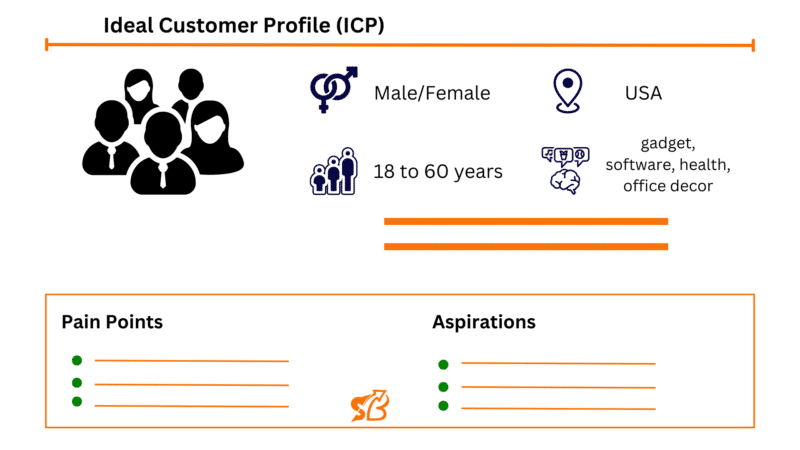
The more insight you have into your audience—their aspirations, pain points, and needs—the better you can position your offerings to attract and serve them effectively.
For example, if you run a SaaS business, the first step is identifying your target market. That means understanding the specific group of people most likely to purchase what you offer.
However, just because your SaaS serves realtors, students, or the healthcare industry doesn’t mean everyone in those fields is your ideal client. Many other factors shape a buyer’s persona, such as their specific needs, budget, and decision-making process.
So, your focus should be on the RIGHT prospects—the ones who not only need your solution but also have the willingness and capacity to invest in it.
Once you have these foundations in place, it’s time to leverage digital marketing strategies to reach your ideal customers.
Here are the best practices for attracting clients through digital marketing.
Inbound marketing strategy: Optimize Your Website For Search Engines (SEO)
Here is some interesting data, According to Google, 83% of U.S. shoppers who visited a store in the last week say they used online search before going into a store. Most of them either use Google or ChatGPT to research products or services.
So, there are two things to consider:
- You must be online to target these customers; otherwise, you’re missing a huge audience.
- You should help these buyers in their buying journey to build brand recognition and acquire customers.
And this is exactly what SEO helps you achieve.
With SEO, you identify what people are searching for (that’s keyword research), create content that aligns with your audience’s needs (that’s the content side of SEO), and optimize it well enough to rank on the first page of search engines (e.g., Google, Bing, Perplexity) or appear in AI tools like ChatGPT.
Whenever potential clients search for a product like yours, SEO ensures you capture as many of them as possible.
But customer acquisition is just one benefit of SEO.
SEO should do much more—it should establish your business as an authoritative brand, as discussed earlier.
Creating content that is valuable and aligned with your audience’s interests allows them to learn more about your business, builds trust, and showcases your expertise. This also positions your SaaS tool or product as the best solution for potential clients.
By producing the right content, you can build relationships with clients who recognize the need for your product.
Think of yourself as the founder of a CRM software company that helps businesses manage customer relationships.
If someone searches for “best CRM for small businesses” and lands on your website, but your content only talks about the history of CRM instead of comparing features, benefits, and pricing, they’ll likely leave and choose a competitor.
To avoid this, create content that aligns with your audience’s interests.
For example, if you run a CRM software company, write about topics like “How to Choose the Best CRM for Your Business,” “Top CRM Features for Sales Teams,” or “CRM vs. Spreadsheets: Which One is Better for Managing Customers?”
This ensures visitors find valuable, relevant information that keeps them engaged with your brand.
Now, the important question is: how do you determine whether your clients are searching for your products and services?
It’s quite simple.
You can use any free keyword research tool, like Ahrefs’ Keyword Research Tool.
Enter your product name in the search box and hit search. This will help you understand whether you should invest in SEO and how much potential exists in the market.
Here’s another important thing to consider: if a keyword shows a search volume of 100, it doesn’t mean only 100 people search for it per month—it’s just an estimate. People use different search terms to find the same product.
For example, if you sell furniture, potential customers might search for terms like:
- Couches
- Office couches
- Chairs for office
- Filing cabinets
Here are more examples to help you understand.
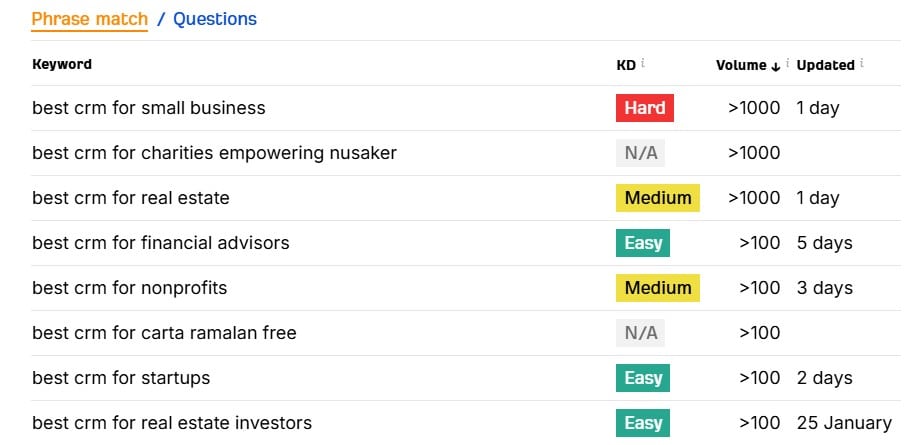
If your business involves CRMs, you can see how different people search for and how much volume each keyword has.
People from different domains use their industries to find the best suitable solution, like these
- best CRM for small business
- best CRM for charities
- best CRM for real estate
- best CRM for financial advisors
- best CRM for nonprofits
- best CRM for startups
- best CRM for real estate investors
It means this has huge potential as many businesses are looking for CRMs.
Here is another example:
If you’re a financial advisor, there are thousands of people searching for financial advisors in the US alone. But it’s a competitive niche, which means more financial advisors are leveraging SEO to get clients.
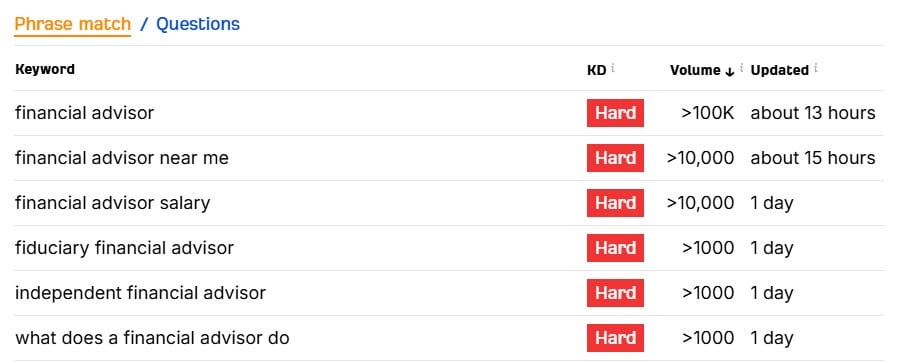
Similarly, you can search for keywords related to your local business—whether it’s a cleaning service, car dealership, or anything else—and you’ll get an idea of the potential and competition.
Now, the last question that might come to mind is: Should you do it yourself?
In my opinion, SEO involves so many technicalities that only experts, who are always up-to-date with Google’s updates and the latest strategies, can effectively manage it.
So, you have two options: either build an in-house team of highly experienced professionals or outsource the work to an expert who already has an established team.
For example, I run my own projects and work with clients, and I have a team for each step. Together, we helped a business generate around $20K in sales by getting them to the top of Google in just a few months.
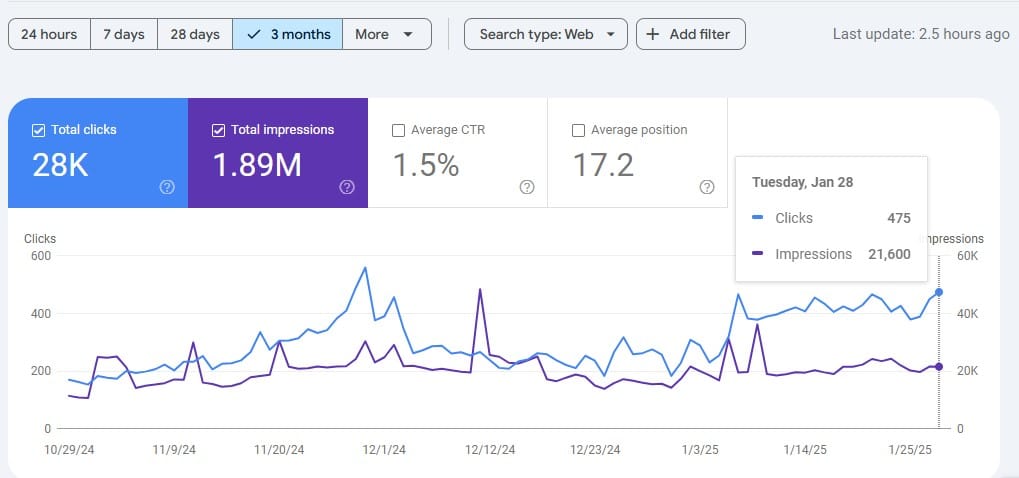

If you want to acquire clients for your business through SEO, I can help with that.
The best part of hiring independent consultants is that it can even save you money.
Inbound Marketing Strategy: Social Media Marketing
With over 5 billion social media users worldwide, it’s the second most powerful tool to attract the right customers.
Here’s why social media is essential for your inbound marketing strategy:
Visibility:
Whether you’re targeting niche communities or broad demographics, your presence on social media allows you to be discovered by potential customers where they spend a lot of their time.
Engagement:
Social media is not just about broadcasting your message; it’s about creating conversations. If you don’t have the right strategy to create useful content to engage your audience, you won’t see results.
By actively engaging with your audience, you can build a community, address their needs, and strengthen brand loyalty.
I know many businesses that have generated hundreds of dollars of revenue from social media alone.
Content Distribution:
Ideally, your social media profiles should be an extension of your website. By sharing valuable content that educates, entertains, or informs, you can drive traffic to your site and increase conversions.
You can also use it as a standalone medium to acquire customers. For instance, through cold messaging or creating viral content, you can attract clients quickly.
But here is the key point.
Just like with SEO, knowing your audience is key to success in social media marketing.
To plan your content for your social media platform, you should know:
- Who are they?
- What problems do they face?
- How can your product or service help?
For example, if you run a SaaS tool for small businesses, posting customer success stories or behind-the-scenes videos showing how your product solves real-world problems can build trust and credibility.
I love a logo designer’s strategy: he creates highly engaging videos as social proof, shares his unique approach, and generates tons of leads from those videos.
The question now is:
How do you use social media to its fullest potential?
It’s simple—choose the platforms where your target audience is most active.
Whether it’s Instagram for visual storytelling or LinkedIn for B2B connections, focus on creating content that speaks directly to your potential customer’s pain points and needs.
But it’s not just about posting regularly—it’s about crafting a strategy.
For instance, I planned content for my social media platforms and I started receiving leads in the first month.
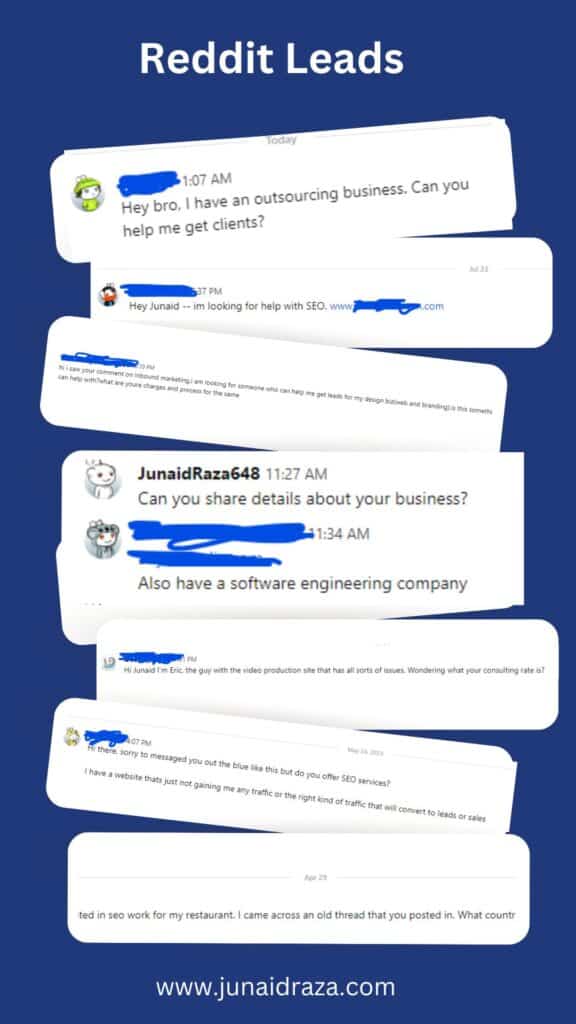
Plan your content, schedule posts, and monitor engagement.
Tools like Hootsuite and Buffer can help automate this process and track performance.
Now, let’s talk about something essential for success: consistency.
Whether you’re posting once a week or daily, you should be consistent.
Maintaining a consistent presence on social media helps build brand awareness and keeps you top of mind for potential customers.
The final question is: Should you manage your social media in-house or hire a pro?
While you can manage it yourself, it can be time-consuming. Social media marketing requires constant monitoring, content creation, and analysis to stay ahead. That’s why many businesses choose to outsource this task to experts who understand the latest trends and strategies.
Use Influencer Marketing:
If you don’t have the time to build an audience around your own social media assets, you can use influencer marketing to make quick sales.
Influencer marketing allows you to leverage the credibility and reach of influencers to promote your products or services.
By partnering with influencers who have a strong following in your industry or niche, you can quickly gain exposure to a highly engaged audience.
For example, if you’re in the beauty industry, collaborating with beauty influencers on platforms like Instagram or YouTube can help showcase your products to their loyal followers, driving both awareness and sales.
Influencers already have the trust of their audience, so their endorsement can have a significant impact on your brand’s credibility and reputation.
Outbound Strategy: Email Marketing
Email marketing is another powerful tool that many tech companies and small businesses use to get clients.
With an average ROI of $36 for every $1 spent, it’s a cost-effective way to engage with your audience and drive sales.
Just like with any other marketing strategy, knowing your audience is key.
- Who are they?
- What are their pain points?
- How can your product or service solve their problems?
For example, if you offer cybersecurity services, you could send cold emails offering a free security audit or tips on “How to Identify Vulnerabilities in Your Business Network.”
This approach not only demonstrates your expertise but also encourages potential clients to take action by addressing their immediate security concerns.
The question now is: how do you create an effective email marketing campaign?
It’s simple—start with a solid strategy.
Create compelling subject lines, engaging content, and a clear call to action. Segment your email list so you can send relevant content to different groups based on their interests and behaviors.
But it’s not just about sending emails—it’s about optimizing them.
Test your subject lines, track open rates, and monitor click-through rates to continuously improve your email campaigns.
Tools like Mailchimp and Constant Contact can help you automate and manage your email marketing campaigns, providing insights and analytics to refine your strategy.
The last thing that matters the most here is patience.
To be successful, you need to email regularly without overwhelming your audience. Whether it’s weekly, bi-weekly, or monthly, consistency helps keep your brand on its radar and encourages ongoing engagement.
Leverage Video Marketing:
As I mentioned earlier with the logo designer example, video marketing can be an incredibly powerful tool for attracting clients.
If your target audience consumes a lot of video content—whether they’re in industries like automotive, design, or any other field—it should absolutely be one of your top priorities.
Creating highly engaging, valuable videos that resonate with your audience not only builds your brand but also showcases your expertise in a more personal, dynamic way.
Videos allow you to demonstrate your services, share customer success stories, and provide valuable insights, all of which can establish trust and authority.
When done right, video marketing can drive tons of qualified leads to your business. Whether it’s through YouTube, social media, or even email campaigns, videos can break down complex information, capture attention, and inspire viewers to take action.
It’s all about crafting videos that speak to your audience’s pain points, aspirations, and needs. The more compelling your content, the higher the chances of turning viewers into loyal clients.
Inbound Marketing Strategy: Webinars and Podcasts:
Webinars and podcasts can be a game-changer when it comes to attracting and engaging clients. I know many large companies are leveraging this strategy to drive valuable clients.
So, if your potential clients are looking for in-depth information or solutions—whether in industries like tech, finance, or education—webinars should be a key part of your marketing strategy.
By hosting webinars or joining relevant podcasts as a guest, you provide valuable, actionable insights that not only showcase your expertise but also allow you to interact directly with your audience.
This creates a unique opportunity to build trust, answer questions in real-time, and demonstrate how your services or products can solve their specific problems.
Use Paid Ads: Social Media Ads and Search Engine Ads
There are two powerful ways to use paid ads to attract clients: social media ads and search engine ads.
For businesses selling products, social media platforms like Facebook and Instagram offer an excellent opportunity to reach a wide audience.
Facebook ads are cheaper thus helping you reach more audiences at tight budgets.
As you have a buyer persona, so, with the right targeting, you can promote your products directly to potential customers, making it a great strategy that works for many businesses.
On the other hand, search engine ads, such as Google Ads, can be an alternative to SEO for attracting clients.
While SEO focuses on organic search traffic over time, paid search engine ads allow you to appear at the top of search results almost immediately.

However, this comes at a higher cost compared to SEO. While the results are faster, the ongoing cost of running search engine ads can add up.
In short, if you need fast results and have the budget for it, search engine ads are a great choice. But for long-term, sustainable growth, social media ads and SEO work hand in hand, allowing you to reach your audience in different ways.
